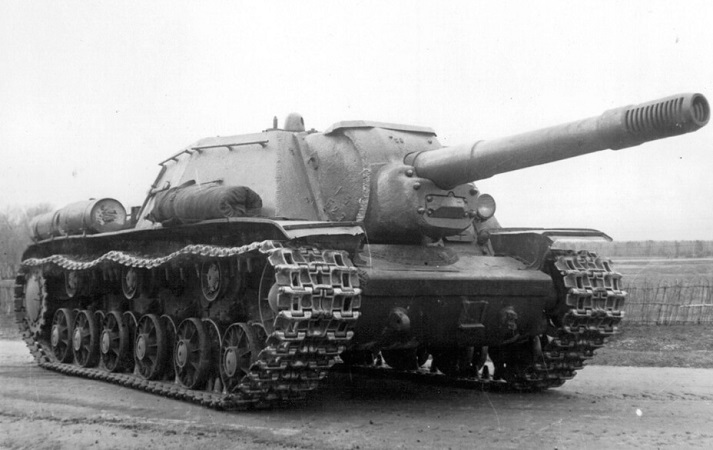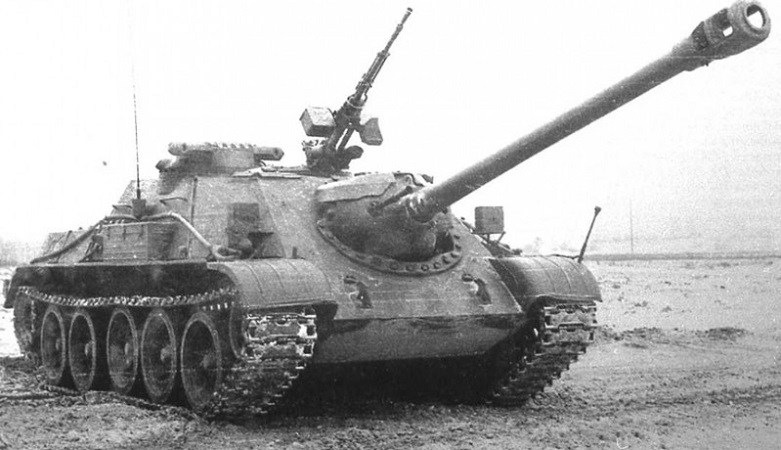● ● ●
The Red Army’s interest in
self-propelled artillery stemmed from its early encounters
with the German Sturmgeschütz
III assault gun, an armored fighting
vehicle (AFV) based on the Panzer III tank with a
short-barreled 75mm gun mounted in an armored casement.
Conceived as an infantry support weapon with superior
mobility and protection compared to the towed 75mm infantry
gun, it proved readily adaptable to the antitank (AT) role
when armed with a high-velocity 75mm gun. The StuG III was
also easier and cheaper to produce than tanks with
equivalent firepower, its only real disadvantage being the
limited traverse of its main gun.
Design work on the first two Soviet
assault guns began in early 1942 and they entered production
late in that year. The SU-76, based on the T-70 light tank,
was armed with the new 76.2mm AT gun mounted in a
lightly armored, open-topped fighting compartment. Thanks to
its simple design the definitive model, designated SU-76M,
became the second most-produced Soviet AFV of the war, after
the T-34 tank. The SU-122 was based on the T-34 tank; it was
armed with a 122mm howitzer in a fully enclosed armored
casement.
The SU-76M and the SU-122 were
supplemented by two other assault guns: the Su-76i and the
SU-57. The former mounted a 76.2mm gun on the chassis of
captured German Panzer III tanks; the latter was the US M48
halftrack mounting a 57mm antitank gun. The SU-76i, though
it proved effective, did not last long thanks to a shortage
of spare parts but the SU-57, of which nearly 500 were
supplied, was well liked for its mobility and mechanical
reliability, and remained in Red Army service until the end
of the war.
The Red Army designated the units
armed with these assault guns as self-propelled (SP)
artillery, but this was something of a misnomer. They were
seldom if ever used as conventional artillery employing
indirect fire. The SU-76M functioned primarily as a tank
destroyer and light assault gun, while the SU-122 served as
a heavy assault gun—both engaging targets by line of sight.
When it first entered service the SU-76M was capable of
destroying any German tank and also proved itself in the
infantry support role, the open-topped fighting compartment
facilitating communication with the infantry. The SU-122 was
equally effective it its designed role, particularly against
fortified positions.
The first SP artillery regiments
were set up in late 1942 and they entered combat in early
1943. These were mixed units, with sixteen SU-76Ms in four
batteries and eight SU-122s in two batteries. But this
configuration proved to be less than ideal. The two weapons
had quite different characteristics and could not easily
operate together. Moreover, with two different types in the
same regiment intermediate battalion headquarters were
necessary, an inefficient use of manpower. Accordingly the
SP artillery regiments were reorganized to embody a single
type: light (SU-76M), medium (SU-122) and heavy (SU-152 when
it entered production in early 1943).

The SU-152 armored assault
gun (Red Army photo)
The SU-152 was based on the KV
heavy tank and was armed with a 152mm howitzer. Though
designed as a heavy assault gun the SU-152 somewhat
surprisingly proved effective as a tank destroyer firing
standard high-explosive ammunition. Though the howitzer’s
muzzle velocity was relatively low, the 152mm HE projectile
was so large that a direct hit could be counted on to
destroy any German AFV. In the Battle of Kursk the SU-152
gained a fearsome reputation as a tank killer, proving
itself
capable of blowing off the turret of a heavy Tiger tank with
a single well-aimed shot.
The success of these first three
assault guns encouraged the Red Army to develop the concept
further. The SU-85, which entered production in mid-1943,
was based on the SU-122 but with the new 85mm antitank gun
in place of the 122mm howitzer. It was designed
to serve primarily as a tank destroyer, as was its successor, the
SU-100 with the more powerful 100mm antitank gun. The SU-122
and SU-152 were eventually replaced in production by the
JSU-122 and JSU-152. These were based on the JS series of
heavy tanks, with thicker armor and various other
improvements.
By 1944 the SP artillery regiments
had become standardized, differing only in the number of
personnel required for their assigned weapons system. All
had twenty assault guns or tank destroyers in five
batteries, plus a T-34 tank in the regimental headquarters
(sometimes replaced by a twenty-first assault gun or tank
destroyer). Like the tank brigades and the heavy tank
regiments they included a motorized submachine gun company
and a motorized antitank rifle company—experience having
demonstrated that close infantry support was very necessary,
particularly in urban combat.

The SU-100 armored tank
destroyer (Red Army photo)
The 1944-45
tank corps and
mechanized corps
usually had three SP artillery regiments: one light, one
medium, one heavy. Others were held at army or front level
to be allocated as circumstances dictated, and sometimes
they were grouped under a brigade headquarters. In mid-1944
Guards rifle divisions were authorized an SP artillery
battalion with sixteen SU-76M, but not all received them
before the war ended. This divisional battalion did not
include an infantry component, since that could be provided
by the division, each of its three rifle regiments including
two independent SMG companies.
The assault guns and tank
destroyers of the Red Army’s SP artillery proved themselves
in combat and some models, particularly the SU-100 and
JSU-152, remained in service for many wars after the war.
Considerable numbers were supplied to the Warsaw Pact
countries, China and other socialist states. The SU-100, for
example, was in widespread service as late as 1980. Some are
still serving today in the armies of North Korea and
Vietnam: a testament to the soundness of the SU-100’s
design.
● ● ●